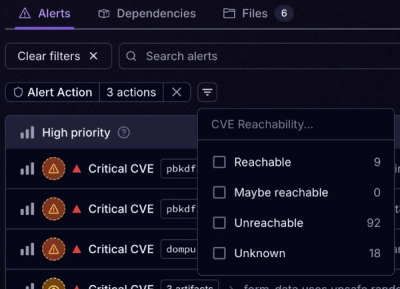
Product
Announcing Socket Fix 2.0
Socket Fix 2.0 brings targeted CVE remediation, smarter upgrade planning, and broader ecosystem support to help developers get to zero alerts.
markdown-it-dollarmath
Advanced tools
A markdown-it plugin for $-delimited math environments.
See https://executablebooks.github.io/markdown-it-dollarmath/ for a demonstration!
Note there is a similar plugin markdown-it-texmath.
markdown-it-dollarmath package differs in that it is optimised for dollar math:
it is more performant, handles backslash \\ escaping properly, and allows for more configuration.
Options:
allow_space: Parse inline math when there is space after/before the opening/closing $, e.g. $ a $allow_digits: Parse inline math when there is a digit before/after the opening/closing $, e.g. 1$ or $2double_inline: Search for double-dollar math within inline contextsallow_labels: Capture math blocks with label suffix, e.g. $$a=1$$ (eq1)labelNormalizer: Function to normalize the label, by default replaces whitespace with - (to align with HTML5 ids)You should "bring your own" math render, provided as an option to the plugin. This function should take the string plus (optional) options, and return a string. For example, below the KaTeX render is used.
As a Node module:
import { renderToString } from "katex"
import MarkdownIt from "markdown-it"
import dollarmathPlugin from "markdown-it-dollarmath"
const mdit = MarkdownIt().use(dollarmathPlugin, {
allow_space: true,
allow_digits: true,
double_inline: true,
allow_labels: true,
labelNormalizer(label) {
return label.replace(/[\s]+/g, "-")
},
renderer(content, { displayMode }) {
return renderToString(content, { displayMode, throwOnError: false })
},
labelRenderer(label) {
return `<a href="#${label}" class="mathlabel" title="Permalink to this equation">¶<a>`
}
})
const text = mdit.render("$a = 1$")
In the browser:
<!doctype html>
<html>
<head>
<title>Example Page</title>
<link
rel="stylesheet"
href="https://cdn.jsdelivr.net/npm/katex/dist/katex.min.css"
/>
<script src="https://cdn.jsdelivr.net/npm/markdown-it@12/dist/markdown-it.min.js"></script>
<script src="https://cdn.jsdelivr.net/npm/katex/dist/katex.min.js"></script>
<script src="https://unpkg.com/markdown-it-dollarmath"></script>
</head>
<body>
<div id="demo"></div>
<script>
const options = {
renderer: (content, { displayMode }) =>
katex.renderToString(content, { displayMode, throwOnError: false })
}
const text = markdownit()
.use(window.markdownitDollarmath, options)
.render("$a = 1$")
document.getElementById("demo").innerHTML = text
</script>
</body>
</html>
package.jsonLICENSEREADME.mdrollup.config.jsnode_module dependencies: npm install or npm ci (see Install a project with a clean slate).npm run format, and linting: npm run lint:fix.npm test, or with coverage; npm test -- --coverage.Now you can start to adapt the code in src/index.ts for your plugin, starting with the markdown-it development recommendations.
Modify the test in tests/fixtures.spec.ts, to load your plugin, then the "fixtures" in tests/fixtures, to provide a set of potential Markdown inputs and expected HTML outputs.
On commits/PRs to the main branch, the GH actions will trigger, running the linting, unit tests, and build tests.
Additionally setup and uncomment the codecov action in .github/workflows/ci.yml, to provide automated CI coverage.
Finally, you can update the version of your package, e.g.: npm version patch -m "🚀 RELEASE: v%s" (patch/minor/major), push to GitHub; git push --follow-tags, build; npm run build, and publish; npm publish.
Finally, you can adapt the HTML document in docs/, to load both markdown-it and the plugin (from unpkg), then render text from an input area.
This can be deployed by GitHub Pages.
FAQs
A markdown-it plugin for $-delimited math.
The npm package markdown-it-dollarmath receives a total of 587 weekly downloads. As such, markdown-it-dollarmath popularity was classified as not popular.
We found that markdown-it-dollarmath demonstrated a not healthy version release cadence and project activity because the last version was released a year ago. It has 3 open source maintainers collaborating on the project.
Did you know?

Socket for GitHub automatically highlights issues in each pull request and monitors the health of all your open source dependencies. Discover the contents of your packages and block harmful activity before you install or update your dependencies.

Product
Socket Fix 2.0 brings targeted CVE remediation, smarter upgrade planning, and broader ecosystem support to help developers get to zero alerts.

Security News
Socket CEO Feross Aboukhadijeh joins Risky Business Weekly to unpack recent npm phishing attacks, their limited impact, and the risks if attackers get smarter.

Product
Socket’s new Tier 1 Reachability filters out up to 80% of irrelevant CVEs, so security teams can focus on the vulnerabilities that matter.